|
View 1839 to 1929
|
May 21-22, 1932
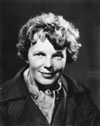 Amelia Earhart becomes the first woman to fly across the Atlantic Ocean alone, crossing in 14 hours and 56 minutes. Amelia Earhart becomes the first woman to fly across the Atlantic Ocean alone, crossing in 14 hours and 56 minutes.
|
March 17, 1937
Ms. Earhart and her navigator, Fred Noonan, begin their attempt to circumnavigate the world using an equatorial route. On July 2, 1937, the airplane and crew were missing after three-quarters of the 29,000 mile journey had been completed.
[more about aviation pioneers]
|
|
December 8, 1941
The United States enters World War II
|
May 1942-August 1943
Several branches of the military including the Army, Navy, Coast Guard, and  Marines establish units for women. Women in the Marines and Coast Guard could not serve outside the continental U.S. until 1944. Marines establish units for women. Women in the Marines and Coast Guard could not serve outside the continental U.S. until 1944.
|
1945
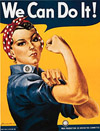 Women have been successfully recruited in the war effort. By 1945, 18 million women are in the U.S. labor force, an increase of 50 percent from 1940. "Rosie the Riveter" becomes a symbol for women's role in the defense industry. Women have been successfully recruited in the war effort. By 1945, 18 million women are in the U.S. labor force, an increase of 50 percent from 1940. "Rosie the Riveter" becomes a symbol for women's role in the defense industry.
[more about Rosie the Riveter]
|
August 14, 1945
World War II officially ends.
|
|
May 20, 1953
 Jacqueline Cochran, flying an F86 Sabre Jet with Chuck Yeager as her chase pilot, becomes the first woman to break the sound barrier. Jacqueline Cochran, flying an F86 Sabre Jet with Chuck Yeager as her chase pilot, becomes the first woman to break the sound barrier.
[more about aviation pioneers]
|
1956
President Eisenhower signs the Federal Aid Highway Act and Highway Revenue Act,  creating the Highway Trust Fund as a financing mechanism for the Interstate System (approved in 1944). creating the Highway Trust Fund as a financing mechanism for the Interstate System (approved in 1944).
|
1956
 Edith M. Flanigen begins work on crystalline zeolytes, or "molecular sieves," which can be used to filter and separate complex mixtures. Zeolyte technology improves the conversion of crude oil to gasoline, water purification, and environmental clean-up processes. Edith M. Flanigen begins work on crystalline zeolytes, or "molecular sieves," which can be used to filter and separate complex mixtures. Zeolyte technology improves the conversion of crude oil to gasoline, water purification, and environmental clean-up processes.
[more about chemical engineering ]
|
1959
Geraldine "Jerrie" Cobb becomes the first woman selected for the Mercury astronaut test.
[more about space travel]
|
|
1961
 Jane Jacobs publishes The Death and Life of Great American Cities which becomes one of the most influential books in the history of city planning. The emphasis on mixed land uses and the scale of streets has been influential in pedestrian and transit planning. Jane Jacobs publishes The Death and Life of Great American Cities which becomes one of the most influential books in the history of city planning. The emphasis on mixed land uses and the scale of streets has been influential in pedestrian and transit planning.
[more about pedestrian & urban design]
|
April 2, 1962
Beverly Cover becomes the first woman highway engineer to join the Bureau of Public Roads, predecessor of the Federal Highway Administration.
|
1963
The Equal Pay Act requires equal wages for men and women doing equal work.

|
1964
The Civil Rights Act prohibits discrimination against women by any company with at least 25 employees.
|
1965
Stephanie Louise Kwolek discovers liquid crystalline polymers, which eventually leads to the development of Kevlar. Originally intended to reinforce the rubber in radial tires, Kevlar is used for mooring cables, aircraft and space vehicle parts, sails, and bullet-proof vests.
[more about chemical engineering ]
|
|
|
February 7, 1983
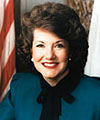 Elizabeth Hanford Dole is sworn in as the Secretary of the Department of Transportation. During her four year tenure at the DOT, she made a critical decision to implement mandatory rear window brake lights. Elizabeth Hanford Dole is sworn in as the Secretary of the Department of Transportation. During her four year tenure at the DOT, she made a critical decision to implement mandatory rear window brake lights.
[more about administration]
|
June 17, 1983
Sally Ride becomes the first U.S. female astronaut as a mission specialist for STS-7 on the six-day flight of Challenger launched from the Kennedy Space Center.
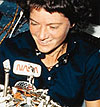
[more about space travel]
|
1983
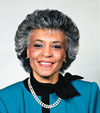 Carmen Turner becomes the General Manager of the Washington Metropolitan Area Transit Authority (WMATA). She is the first African-American woman to lead a major transit agency. Carmen Turner becomes the General Manager of the Washington Metropolitan Area Transit Authority (WMATA). She is the first African-American woman to lead a major transit agency.
|
April 19, 1989
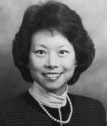 Elaine Lan Chao is confirmed as Deputy Secretary of Transportation Elaine Lan Chao is confirmed as Deputy Secretary of Transportation
|
|
September 12, 1992
Mae Jemison becomes the first African-American woman astronaut in space.

|
September 25, 1996
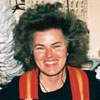 Astronaut Shannon Lucid sets a U.S. record for the longest stay in space (188 days and 4 hours). Astronaut Shannon Lucid sets a U.S. record for the longest stay in space (188 days and 4 hours).
[more about space travel]
|
|
?
|